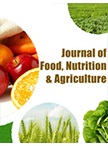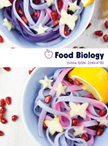Nutritional value of grain and leafy Amaranth varieties grown in Tanzania
DOI:
https://doi.org/10.21839/jfna.2023.v6.8313Keywords:
Amaranths varieties, Nutrients content, Anti-nutrients content, Amaranth leaves, Amaranth grainsAbstract
Amaranth leaves and seeds are highly nutritious, but less is clearly known for the varieties grown in Tanzania. Grains, leaves (dry and fresh) and flower part of amaranth were analyzed for minerals (iron, zinc, copper and manganese), proximate (crude protein, crude fat, crude fibre and carbohydrate) and anti-nutrients (nitrate and oxalate) content. Minerals were significantly higher (p<0.05) in fresh leafy varieties performing 75.89 mg/100 g, 3.284 mg/100 g and 34.869 mg/100 g for Amaranthus hypochondriacus (Nafaka), A. hypochondriacus (Lishe njano) and A. dubius (White local) respectively, with iron being significantly higher in dried leaves (284.384 mg/1000 g) of A. dubius (Bwasi jekundu). Protein, Fat and Fibre content is significantly higher in grains of amaranths indicating Crude protein (15.787%) in A. cruentus (Bwasi kijani), Crude Fibre (13.040% and 13.163%) in White local and Bwasi jekundu respectively that are not significantly different (p>0.05) and Crude Fat (9.273%) in Bwasi jekundu. Total Carbohydrate (78.743%) is significantly higher in dried Bwasi kijani. Anti-nutrient contents were significantly higher in dried compared to fresh leaf varieties, grain and amaranth flowers. Oxalate ranging from 378.5 to 360.3 mg/100 g and are not significantly different (p>0.05) within varieties, nitrate (137.06 μg/g) is significantly higher in A. hybridus (Lishe nyeupe) of dried leaves compared to fresh, grains and amaranth flower. Bwasi jekundu appears to be the best variety as dried leaves have the highest iron, since micronutrients are of more significance in leaves of vegetables than macro nutrients.
Downloads
References
AOAC. (1990). Official Method of analysis of AOAC. (14th ed.). Allengton, Washington: Association of Official Analytical Chemist, Inc.
AOAC. (1995). Official Methods of Analysis. (16th ed.). Allengton, Washington: Association of Official Analytical Chemist, Inc.
Daniel, C. H. (2003). Quantitative Chemical Analysis. (6th ed.), New York, USA: W. H. Freeman and Company.
Duncan, D. B. (1955). Multiple range and multiple F-tests. Biometrics, 11(1), 1-42. https://doi.org/10.2307/3001478
Escudero, N. L., Zirulnik, F., Gomez, N. N., Mucciarelli, S. I., Mucciarelli, S. I., & Ginènez, M. S. (2006). Influence of a protein concentrate from Amaranthus cruentus seeds on lipid metabolism. Experimental Biology and Medicine, 231(1), 50-59. https://doi.org/10.1177/153537020623100106
Eslami, A., Khaniki, G. R. J., Nurani, M., Mehrasbi, M., Peyda, M., & Azmi, R. (2007). Heavy metals in edible green vegetables grown along the river sites of the rivers of Iran. Journal of Biological Sciences, 7(6), 943-948. https://doi.org/10.3923/jbs.2007.943.948
Gaya, U. I., & Alimi, S. (2000). Spectrophotometric determination of Nitrate in Vegetables using phenol. Journal of Applied Sciences and Environmental Management, 10(1), 79-82.
Grubben, G. J. H. (2004). Amaranthus blitum L. In G. J. H. Grubben & O. A. Denton (Eds.), Vegetables (Vol. 2, pp. 74-83) Wageningen, Netherlands: PROTA Foundation.
Joshi, P., & Mehta, D. (2010). Effect of dehydration on the nutritive value of drumstick leaves. Journal of Metabolomics and Systems Biology, 1(1), 5-9.
Kirk, R. S., & Sawyer, R. (1991). Pearson’s Composition and Analysis of Foods. (9th ed.). London, UK: Longman Scientific and Technical.
Makobo, N. D., Shoko, M. D., & Mtaita, T. A. (2010). Nutrient Content of Amaranth (Amaranthus cruentus L.) Under Different Processing and Preservation Methods. World Journal of Agricultural Sciences, 6(6), 639-643.
McDonald, P., Edwards, R. A., & Green-halgh, J. F. D. (1973). Animal Nutrition. Edinburgh, UK: T and A Constable Ltd.
Mnkeni, A. P., Masika, P., & Maphaha, M. (2007). Nutritional quality of vegetable and seed from different accessions of Amaranthus in South Africa. Water SA, 33(3),377-380. https://doi.org/10.4314/wsa.v33i3.49119
Myers, R. L. (2004). Grain amaranth, a lost crop of the Americans. Small Farm Today, 21(3), 28-32.
Rai, N., & Yadav, D. S. (2005). Advances in Vegetable Production (pp. 550 -558). New Delhi, India: Researchco Book Center.
RSA. (2010). Amaranthus: Production guideline. Pretoria, Republic of South Africa: Department of Agriculture, Forestry and Fisheries.






 .
.